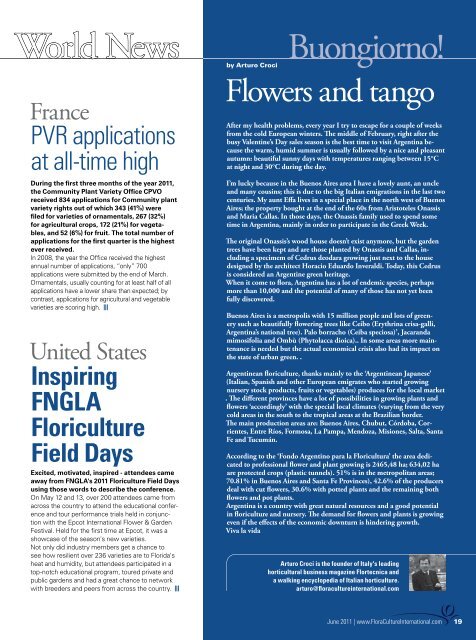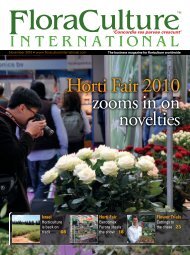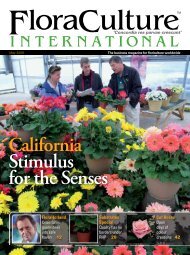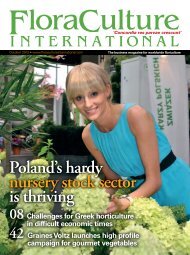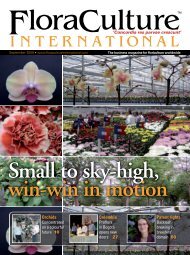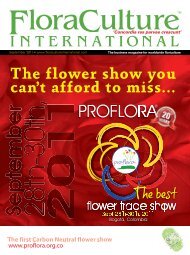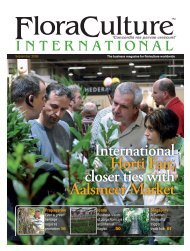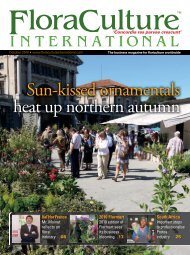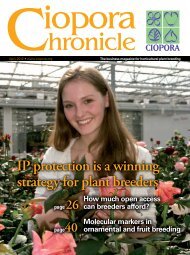12 A sea of flowers at 2011 Pack Trials - Floraculture International
12 A sea of flowers at 2011 Pack Trials - Floraculture International
12 A sea of flowers at 2011 Pack Trials - Floraculture International
You also want an ePaper? Increase the reach of your titles
YUMPU automatically turns print PDFs into web optimized ePapers that Google loves.
World News<br />
by Arturo Croci<br />
Buongiorno!<br />
France<br />
PVR applic<strong>at</strong>ions<br />
<strong>at</strong> all-time high<br />
During the first three months <strong>of</strong> the year <strong>2011</strong>,<br />
the Community Plant Variety Office CPVO<br />
received 834 applic<strong>at</strong>ions for Community plant<br />
variety rights out <strong>of</strong> which 343 (41%) were<br />
filed for varieties <strong>of</strong> ornamentals, 267 (32%)<br />
for agricultural crops, 172 (21%) for vegetables,<br />
and 52 (6%) for fruit. The total number <strong>of</strong><br />
applic<strong>at</strong>ions for the first quarter is the highest<br />
ever received.<br />
In 2008, the year the Office received the highest<br />
annual number <strong>of</strong> applic<strong>at</strong>ions, “only” 700<br />
applic<strong>at</strong>ions were submitted by the end <strong>of</strong> March.<br />
Ornamentals, usually counting for <strong>at</strong> least half <strong>of</strong> all<br />
applic<strong>at</strong>ions have a lower share than expected; by<br />
contrast, applic<strong>at</strong>ions for agricultural and vegetable<br />
varieties are scoring high. |||<br />
United St<strong>at</strong>es<br />
Inspiring<br />
FNGLA<br />
Floriculture<br />
Field Days<br />
Excited, motiv<strong>at</strong>ed, inspired - <strong>at</strong>tendees came<br />
away from FNGLA's <strong>2011</strong> Floriculture Field Days<br />
using those words to describe the conference.<br />
On May <strong>12</strong> and 13, over 200 <strong>at</strong>tendees came from<br />
across the country to <strong>at</strong>tend the educ<strong>at</strong>ional conference<br />
and tour performance trials held in conjunction<br />
with the Epcot Intern<strong>at</strong>ional Flower & Garden<br />
Festival. Held for the first time <strong>at</strong> Epcot, it was a<br />
showcase <strong>of</strong> the <strong>sea</strong>son's new varieties.<br />
Not only did industry members get a chance to<br />
see how resilient over 236 varieties are to Florida's<br />
he<strong>at</strong> and humidity, but <strong>at</strong>tendees particip<strong>at</strong>ed in a<br />
top-notch educ<strong>at</strong>ional program, toured priv<strong>at</strong>e and<br />
public gardens and had a gre<strong>at</strong> chance to network<br />
with breeders and peers from across the country. |||<br />
Flowers and tango<br />
After my health problems, every year I try to escape for a couple <strong>of</strong> weeks<br />
from the cold European winters. The middle <strong>of</strong> February, right after the<br />
busy Valentine’s Day sales <strong>sea</strong>son is the best time to visit Argentina because<br />
the warm, humid summer is usually followed by a nice and pleasant<br />
autumn: beautiful sunny days with temper<strong>at</strong>ures ranging between 15°C<br />
<strong>at</strong> night and 30°C during the day.<br />
I’m lucky because in the Buenos Aires area I have a lovely aunt, an uncle<br />
and many cousins; this is due to the big Italian emigr<strong>at</strong>ions in the last two<br />
centuries. My aunt Effa lives in a special place in the north west <strong>of</strong> Buenos<br />
Aires; the property bought <strong>at</strong> the end <strong>of</strong> the 60s from Aristoteles Onassis<br />
and Maria Callas. In those days, the Onassis family used to spend some<br />
time in Argentina, mainly in order to particip<strong>at</strong>e in the Greek Week.<br />
The original Onassis’s wood house doesn’t exist anymore, but the garden<br />
trees have been kept and are those planted by Onassis and Callas, including<br />
a specimem <strong>of</strong> Cedrus deodara growing just next to the house<br />
designed by the architect Horacio Eduardo Inveraldi. Today, this Cedrus<br />
is considered an Argentine green heritage.<br />
When it come to flora, Argentina has a lot <strong>of</strong> endemic species, perhaps<br />
more than 10,000 and the potential <strong>of</strong> many <strong>of</strong> those has not yet been<br />
fully discovered.<br />
Buenos Aires is a metropolis with 15 million people and lots <strong>of</strong> greenery<br />
such as beautifully flowering trees like Ceibo (Erythrina crisa-galli,<br />
Argentina’s n<strong>at</strong>ional tree). Palo borracho (Ceiba speciosa)’, Jacaranda<br />
mimosifolia and Ombù (Phytolacca dioica).. In some areas more maintenance<br />
is needed but the actual economical crisis also had its impact on<br />
the st<strong>at</strong>e <strong>of</strong> urban green. .<br />
Argentinean floriculture, thanks mainly to the ‘Argentinean Japanese’<br />
(Italian, Spanish and other European emigr<strong>at</strong>es who started growing<br />
nursery stock products, fruits or vegetables) produces for the local market<br />
. The different provinces have a lot <strong>of</strong> possibilities in growing plants and<br />
<strong>flowers</strong> ‘accordingly’ with the special local clim<strong>at</strong>es (varying from the very<br />
cold areas in the south to the tropical areas <strong>at</strong> the Brazilian border.<br />
The main production areas are: Buenos Aires, Chubut, Córdoba, Corrientes,<br />
Entre Ríos, Formosa, La Pampa, Mendoza, Misiones, Salta, Santa<br />
Fe and Tucumán.<br />
According to the ‘Fondo Argentino para la Floricultura’ the area dedic<strong>at</strong>ed<br />
to pr<strong>of</strong>essional flower and plant growing is 2465,48 ha; 634,02 ha<br />
are protected crops (plastic tunnels). 51% is in the metropolitan areas;<br />
70.81% in Buenos Aires and Santa Fe Provinces), 42.6% <strong>of</strong> the producers<br />
deal with cut <strong>flowers</strong>, 30.6% with potted plants and the remaining both<br />
<strong>flowers</strong> and pot plants.<br />
Argentina is a country with gre<strong>at</strong> n<strong>at</strong>ural resources and a good potential<br />
in floriculture and nursery. The demand for <strong>flowers</strong> and plants is growing<br />
even if the effects <strong>of</strong> the economic downturn is hindering growth.<br />
Viva la vida<br />
Arturo Croci is the founder <strong>of</strong> Italy's leading<br />
horticultural business magazine Flortecnica and<br />
a walking encyclopedia <strong>of</strong> Italian horticulture.<br />
arturo@floracultureintern<strong>at</strong>ional.com<br />
June <strong>2011</strong> | www.FloraCultureIntern<strong>at</strong>ional.com 19


